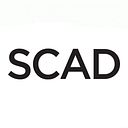Katie Glusica: Reading Creatively
SCAD Professors share their reading lists.
“The words ‘text’ and ‘textile’ share the same Latin root, ‘texere’, which means ‘to weave’,” points out Katie Glusica, SCAD fibers professor, artist, and avowed bibliophile. “We impress upon our fibers students how other disciplines use the language of tapestry and cloth as descriptors. When we talk about writing, for example, we might say ‘weaving a story’. There is a fundamental relationship between words and fibers.”
A peek into Glusica’s personal library shows the diversity of her interests: poetry, astronomy, religion, history, quantum mechanics, fiction. Well-thumbed tomes sport copious Post-Its colored like parakeets’ plumage. Currently conducting SCAD Summer Seminar classes for high school students interested in fibers, Katie is happy to make time to discuss a few topical titles.
Jen Bervin, Silk Poems (Nighboat Books, 2017): “These experimental poems move across the page based on the DNA of silk and the movements of silkworms. This book, as an object, is part of the work itself — the cover and pages feel like silk. A great example of text meets textile.”
James Essinger, Jacquard’s Web: How A Hand-Loom Led to the Birth of the Information Age (Oxford University Press, 2007): “The invention of the Jacquard loom in the early 1800s spurred the Industrial Revolution and ultimately led to the invention of the computer. Because weaving is such a time-consuming process, the Jacquard loom enabled people to afford more material goods and affected socioeconomic dynamics. Fascinating history.”
Brian Greene, Until the End of Time: Mind, Matter, and Our Search for Meaning in an Evolving Universe (Knopf, 2020): “I learned of this book from an interview with the author on New Books Network. I found myself scribbling notes, talking back to the podcast. Greene is a mathematics and physics professor, and he’s big into interdisciplinary thinking, which I like. As humans, we have a crisis if we don’t know what meaning is. So, how do we mine our material for meaning, as artists?”
Tatyana Tolstaya, Aetherial Worlds (Vintage, 2019): “Short short stories, beautifully written. Notes about the human condition and soul from a very humanistic and humoristic place. The language is amazing. There’s almost a sense of magical realism. Yes, she’s a descendant of Tolstoy, who makes an appearance in one of the stories. I’ve read this whole book twice. Do you want to borrow it?”
Joan Livingstone (editor) & John Ploof (editor), The Object of Labor: Art, Cloth, and Cultural Production (The MIT Press, 2007): “This is a textbook used in the SCAD fibers department, typically with graduate students. It’s a series of essays. I’m particularly fond of ‘Material and Memory’ by Mary Jane Jacob, where she makes connections between cloth, daily life and ‘the fabric of society.’”
Ching-In Chen (editor), Jai Dulani (editor), & Leah Lakshmi Piepzna-Samarasinha (editor), The Revolution Starts at Home (AK Press, 2011) and Alain de Botton (editor), The School of Life: An Emotional Education (The School of Life, 2019): “Conflict can happen in any situation, including in the classroom. De-escalating conflict is a form of integrity. These are valuable books on creating healthy interpersonal relationships, the importance of emotional intelligence, and how to form and strengthen movements that can create positive change. Timely!”
By Peter Relic
